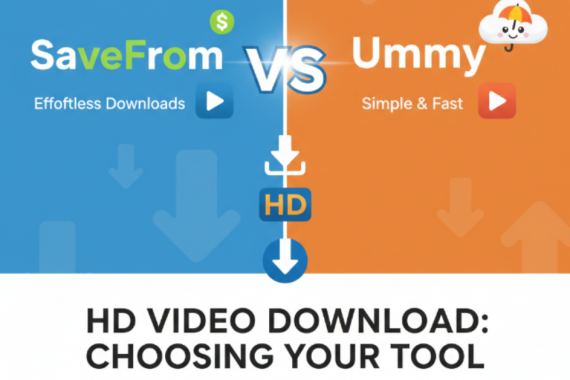
Silakan masukkan kata kunci pada kolom pencarian



HD Video Download: SaveFrom vs Ummy
- Ditulis Oleh
- Rio Quiserto
- 8 Oktober 2025
Daftar Isi

In today's digital landscape, the demand for reliable video downloading solutions has grown exponentially. With billions of hours of video content uploaded daily across various platforms, users frequently need efficient tools to save their favorite content for offline viewing.
This comprehensive analysis examines two prominent solutions in the video downloading space: SaveFrom and Ummy, helping users make informed decisions about their HD video downloading needs.
Understanding the Video Download Landscape
The video downloading industry has evolved significantly over the past decade. According to the International Telecommunication Union (ITU), global internet traffic has increased by over 25% annually, with video content comprising more than 75% of all internet traffic. This massive shift toward video consumption has created a substantial demand for reliable downloading tools that can handle various formats and quality levels.
Modern video downloaders must address several key challenges: supporting multiple platforms, maintaining download speeds that match available bandwidth, preserving video quality, and providing user-friendly interfaces. The competition between different services has driven innovation in areas such as format conversion, batch downloading, and mobile compatibility.
SaveFrom: Comprehensive Platform Coverage
SaveFrom has established itself as a versatile online video downloading service that supports over 40 different platforms. The service's browser-based approach eliminates the need for software installation, making it accessible across different operating systems and devices.
Platform Support and Compatibility
One of SaveFrom's strongest features is its extensive platform support. Users can download content from major social media platforms, video hosting sites, and streaming services. The platform's ability to handle diverse video sources makes it particularly valuable for users who consume content across multiple platforms.
The service's web-based architecture provides several advantages. Users can access the tool from any device with a browser, whether desktop, tablet, or smartphone. This cross-platform compatibility ensures consistent functionality regardless of the user's preferred device or operating system.
For users looking to download video Tiktok content, SaveFrom offers streamlined processing that maintains the original quality while providing multiple format options. The service processes TikTok videos efficiently, preserving both audio and video quality while offering various resolution choices to suit different storage and bandwidth requirements.
Technical Capabilities and Performance
SaveFrom's technical infrastructure is designed to handle high-volume requests while maintaining download speeds. The service employs distributed servers to optimize performance based on user location, reducing latency and improving overall download times.
The platform supports multiple video qualities, typically ranging from 144p to 4K resolution, depending on the source material's availability. This flexibility allows users to balance file size considerations with quality requirements. For users with limited storage space, lower resolutions provide acceptable quality with significantly smaller file sizes. Conversely, users prioritizing maximum quality can select the highest available resolution.
Format support is another area where SaveFrom excels. The service can handle MP4, WebM, and 3GP formats, with MP4 being the most commonly used due to its broad compatibility with media players and devices. The automatic format detection feature simplifies the download process by selecting optimal settings based on the source content.
User Experience and Interface Design
SaveFrom's interface prioritizes simplicity without sacrificing functionality. The clean, intuitive design allows users to quickly paste video URLs and initiate downloads with minimal steps. The service provides clear feedback throughout the download process, including progress indicators and estimated completion times.
The platform's responsive design ensures optimal functionality across different screen sizes and devices. Mobile users benefit from touch-optimized controls and streamlined interfaces that accommodate smaller screens while maintaining full functionality.
Ummy: Desktop-Focused Solution
Ummy takes a different approach to video downloading by offering a dedicated desktop application. This software-based solution provides deep integration with the user's operating system and offers features that web-based alternatives cannot match.
Software Installation and System Integration
Ummy requires installation on the user's computer, which provides both advantages and considerations. The installed software can integrate more deeply with the operating system, offering features such as system tray notifications, keyboard shortcuts, and direct browser integration through extensions.
The desktop application approach allows Ummy to maintain downloaded video libraries, providing organizational features such as folders, tags, and search functionality. Users can build comprehensive media collections with metadata preservation and easy access to previously downloaded content.
Performance and Resource Management
As a desktop application, Ummy can leverage local system resources more effectively than browser-based alternatives. The software can utilize available RAM and processing power to handle multiple concurrent downloads and perform background processing tasks without browser limitations.
The application's multithreading capabilities enable simultaneous downloads from multiple sources, potentially reducing total download time for users with substantial bandwidth. Queue management features allow users to schedule downloads and prioritize certain content over others.
Video Quality and Format Options
Ummy supports various output formats and quality levels, with particular emphasis on HD and 4K content. The software's local processing capabilities enable on-the-fly format conversion without requiring server-side processing, which can improve privacy and reduce processing delays.
The application provides detailed control over output settings, including bitrate selection, audio quality options, and custom resolution settings. Advanced users can fine-tune these parameters to optimize file sizes for their specific use cases.
Comparative Analysis: Key Differences
Accessibility and Convenience
The fundamental difference between SaveFrom and Ummy lies in their accessibility models. SaveFrom's web-based approach offers immediate access without installation requirements, making it ideal for users who need occasional downloading capabilities or those using shared or restricted computers.
Ummy's desktop application model suits users who frequently download videos and prefer dedicated software with advanced features. The installation requirement may limit accessibility in some environments but provides enhanced functionality for committed users.
Feature Sets and Capabilities
SaveFrom focuses on broad platform support and ease of use, making it excellent for users who download content from diverse sources. The service's strength lies in its universal compatibility and straightforward operation.
Ummy emphasizes advanced features and local processing capabilities. Users who require batch downloading, format conversion, or media library management may find Ummy's feature set more comprehensive for their needs.
Performance Considerations
Download speed performance depends on various factors including server load, network conditions, and source platform limitations. SaveFrom's distributed server infrastructure can provide consistent performance across different geographic regions.
Ummy's local processing approach can offer advantages when dealing with large files or multiple simultaneous downloads, as it can fully utilize available system resources without browser constraints.
Technical Considerations for HD Video Downloads
Understanding Video Quality Metrics
High-definition video downloading requires understanding various quality metrics. Resolution, typically measured in pixels (720p, 1080p, 4K), represents the image clarity and detail level. Higher resolutions provide better visual quality but result in larger file sizes requiring more storage space and bandwidth.
Bitrate, measured in kilobits per second (kbps) or megabits per second (Mbps), determines the amount of data used to represent each second of video. Higher bitrates generally correlate with better quality but increased file sizes. Understanding this relationship helps users make informed decisions about quality versus storage trade-offs.
Frame rate, typically 24, 30, or 60 frames per second, affects video smoothness. Higher frame rates provide smoother motion but require more processing power and storage space. Most video content uses 30fps as a standard, with 60fps reserved for high-action content or gaming videos.
Network and Bandwidth Considerations
Successful HD video downloading requires adequate bandwidth and stable internet connections. Download speeds depend on multiple factors including internet service provider capabilities, network congestion, server performance, and concurrent usage.
Users should consider their internet speed limitations when selecting video quality options. Downloading 4K content on slower connections may result in extended download times or interrupted transfers. Understanding personal bandwidth limitations helps optimize the download experience.
Storage and File Management
HD video files require significant storage space. A single hour of 1080p content can range from 1-8 GB depending on compression settings and source quality. Users should plan storage requirements accordingly and consider external storage solutions for extensive video collections.
File organization becomes crucial when downloading substantial amounts of content. Both SaveFrom and Ummy offer different approaches to file management, with varying levels of automation and user control over organization systems.
Security and Privacy Considerations
Data Protection and User Privacy
Video downloading services handle user data differently based on their architecture and business models. Web-based services like SaveFrom process requests through their servers, which requires transmitting video URLs and potentially other metadata.
Desktop applications like Ummy can process downloads locally, potentially offering enhanced privacy for users concerned about data transmission. However, both approaches have security considerations that users should understand.
Safe Downloading Practices
Regardless of the chosen service, users should follow safe downloading practices. This includes verifying source authenticity, avoiding suspicious links, and maintaining updated antivirus software. Video files can potentially contain malware, though this risk is generally low from reputable platforms.
Understanding copyright implications is essential for responsible downloading. Users should ensure they have appropriate rights to download and store content, respecting intellectual property laws and platform terms of service.
Making the Right Choice: User Scenarios
Casual Users and Occasional Downloads
Users who occasionally download videos for personal use may find SaveFrom's web-based approach more convenient. The immediate accessibility without software installation makes it ideal for infrequent use cases or when using different devices.
The broad platform support ensures that casual users can handle content from various sources without learning different tools or processes. The simplified interface minimizes the learning curve for users who prioritize convenience over advanced features.
Power Users and Content Creators
Users who regularly download substantial amounts of content may benefit from Ummy's desktop application approach. The advanced features, batch processing capabilities, and local media management provide tools that frequent users appreciate.
Content creators who need to download reference materials, source content, or backup their own uploads may find the additional control and organization features valuable for their workflows.
Mobile and Cross-Platform Users
Users who frequently switch between different devices or operating systems may prefer SaveFrom's universal browser-based access. The consistent functionality across platforms eliminates the need to maintain software installations on multiple devices.
Mobile users particularly benefit from web-based solutions that don't require app installations or may not have desktop equivalents available for their platforms.
Future Trends and Developments
Technology Evolution Impact
The video downloading landscape continues evolving with advancing technology. Improved compression algorithms like AV1 codec promise better quality at smaller file sizes, potentially changing storage and bandwidth requirements.
5G network deployment will likely impact downloading patterns, enabling faster transfers and making higher-quality downloads more accessible to mobile users. This technological advancement may shift user preferences toward higher quality content consumption.
Platform Policy Changes
Social media and video platforms regularly update their policies regarding content downloading. These changes can affect the functionality and legality of various downloading tools. Users should stay informed about platform policy updates and their implications for downloading activities.
The ongoing evolution of digital rights management (DRM) technologies may also impact the availability and functionality of certain downloading methods. Understanding these trends helps users make informed long-term decisions about their video downloading strategies.
Conclusion
Both SaveFrom and Ummy offer valuable solutions for HD video downloading, each excelling in different areas and serving different user needs. SaveFrom's web-based approach provides universal accessibility and broad platform support, making it excellent for casual users and those requiring cross-platform compatibility. Ummy's desktop application offers advanced features and local processing capabilities that benefit power users and those requiring extensive media management.
The choice between these solutions ultimately depends on individual user requirements, technical preferences, and usage patterns. Casual users seeking convenience and broad compatibility may prefer SaveFrom's approach, while users requiring advanced features and local control may find Ummy more suitable.
As the digital video landscape continues evolving, both services will likely adapt to meet changing user needs and technological capabilities. Understanding the current strengths and limitations of each approach helps users make informed decisions that best serve their specific video downloading requirements.
Users should consider their typical usage patterns, technical requirements, and privacy preferences when selecting a video downloading solution. Both SaveFrom and Ummy represent solid choices within their respective approaches, offering reliable functionality for different user scenarios and requirements.
Bagikan Melalui
Daftar Isi






Komentar (0 Komentar)